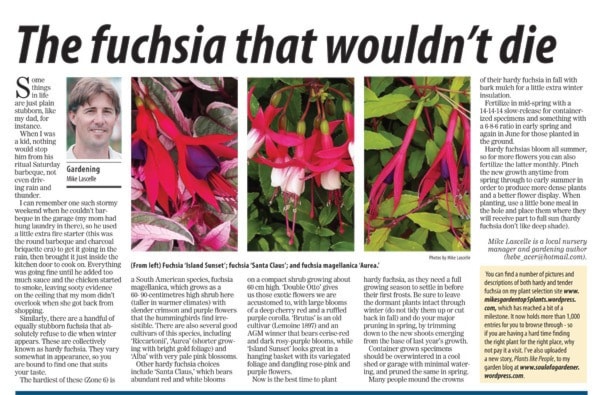Some things in life are just plain stubborn, like my dad, for instance.
When I was a kid, nothing would stop him from his ritual Saturday barbeque, not even driving rain and thunder.
I can remember one such stormy weekend when he couldn’t barbeque in the garage (my mom had hung laundry in there), so he used a little extra fire starter (this was the round barbeque and charcoal briquette era) to get it going in the rain, then brought it just inside the kitchen door to cook on. Everything was going fine until he added too much sauce and the chicken started to smoke, leaving sooty evidence on the ceiling that my mom didn’t overlook when she got back from shopping.
Similarly, there are a handful of equally stubborn fuchsia that absolutely refuse to die when winter appears. These are collectively known as hardy fuchsia. They vary somewhat in appearance, so you are bound to find one that suits your taste.
The hardiest of these (Zone 6) is a South American species, fuchsia magellanica, which grows as a 60- 90-centimetres high shrub here (taller in warmer climates) with slender crimson and purple flowers that the hummingbirds find irresistible. There are also several good cultivars of this species, including ‘Riccartonii’, ‘Aurea’ (shorter growing with bright gold foliage) and ‘Alba’ with very pale pink blossoms.
Other hardy fuchsia choices include ‘Santa Claus,’ which bears abundant red and white blooms on a compact shrub growing about 60 cm high. ‘Double Otto’ gives us those exotic flowers we are accustomed to, with large blooms of a deep cherry red and a ruffled purple corolla. ‘Brutus’ is an old cultivar (Lemoine 1897) and an AGM winner that bears cerise-red and dark rosy-purple blooms, while ‘Island Sunset’ looks great in a hanging basket with its variegated foliage and dangling rose-pink and purple flowers.
Now is the best time to plant hardy fuchsia, as they need a full growing season to settle in before their first frosts. Be sure to leave the dormant plants intact through winter (do not tidy them up or cut back in fall) and do your major pruning in spring, by trimming down to the new shoots emerging from the base of last year’s growth.
Container grown specimens should be overwintered in a cool shed or garage with minimal watering, and pruned the same in spring.
Many people mound the crowns of their hardy fuchsia in fall with bark mulch for a little extra winter insulation.
Fertilize in mid-spring with a 14-14-14 slow-release for containerized specimens and something with a 6-8-6 ratio in early spring and again in June for those planted in the ground.
Hardy fuchsias bloom all summer, so for more flowers you can also fertilize the latter monthly. Pinch the new growth anytime from spring through to early summer in order to produce more dense plants and a better flower display. When planting, use a little bone meal in the hole and place them where they will receive part to full sun (hardy fuchsia don’t like deep shade).
Mike Lascelle is a local nursery manager and gardening author. Email him at hebe_acer@hotmail.com.
Blog
You can find a number of pictures and descriptions of both hardy and tender fuchsia on my plant selection site, which has reached a bit of a milestone. It now holds more than 1,000 entries for you to browse through - so if you are having a hard time finding the right plant for the right place, why not pay it a visit. I’ve also uploaded a new story, Plants like People, to my garden blog.
